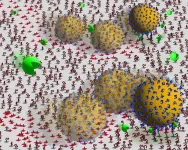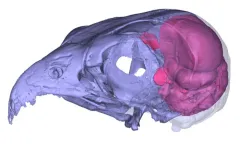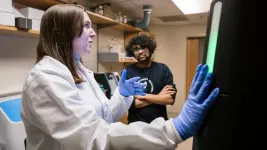(Press-News.org) DNA-nanoparticle motors are exactly as they sound: tiny artificial motors that use the structures of DNA and RNA to propel motion by enzymatic RNA degradation. Essentially, chemical energy is converted into mechanical motion by biasing the Brownian motion. The DNA-nanoparticle motor uses the "burnt-bridge" Brownian ratchet mechanism. In this type of movement, the motor is being propelled by the degradation (or "burning") of the bonds (or "bridges") it crosses along the substrate, essentially biasing its motion forward.
These nano-sized motors are highly programmable and can be designed for use in molecular computation, diagnostics, and transport. Despite their genius, DNA-nanoparticle motors don't have the speed of their biological counterparts, the motor protein, which is where the issue lies. This is where researchers come in to analyze, optimize, and rebuild a faster artificial motor using single-particle tracking experiment and geometry-based kinetic simulation.
"Natural motor proteins play essential roles in biological processes, with a speed of 10-1000 nm/s. Until now, artificial molecular motors have struggled to approach these speeds, with most conventional designs achieving less than 1 nm/s," said Takanori Harashima, researcher and first author of the study.
Researchers published their work in Nature Communications on January 16th, 2025, featuring a proposed solution to the most pressing issue of speed: switching the bottleneck.
The experiment and simulation revealed that binding of RNase H is the bottleneck in which the entire process is slowed. RNase H is an enzyme involved in genome maintenance, and breaks down RNA in RNA/DNA hybrids in the motor. The slower RNase H binding occurs, the longer the pauses in motion, which is what leads to a slower overall processing time. By increasing the concentration of RNase H, the speed was markedly improved, showing a decrease in pause lengths from 70 seconds to around 0.2 seconds.
However, increasing motor speed came at the cost of processivity (the number of steps before detachment) and run-length (the distance the motor travels before detachment). Researchers found that this trade-off between speed and processivity/run-length could be improved by a larger DNA/RNA hybridization rate, bringing the simulated performance closer to that of a motor protein.
The engineered motor, with redesigned DNA/RNA sequences and a 3.8-fold increase in hybridization rate, achieved a speed of 30 nm/s, 200 processivity, and a 3 μm run-length. These results demonstrate that the DNA-nanoparticle motor is now comparable to a motor protein in performance.
"Ultimately, we aim to develop artificial molecular motors that surpass natural motor proteins in performance," said Harashima. These artificial motors can be very useful in molecular computations based on the motion of the motor, not to mention their merit in the diagnosis of infections or disease-related molecules with a high sensitivity.
The experiment and simulation done in this study provide an encouraging outlook for the future of DNA-nanoparticle and related artificial motors and their ability to measure up to motor proteins as well as their applications in nanotechnology.
Takanori Harashima, Akihiro Otomo, and Ryota Iino of the Institute for Molecular Science at National Institutes of Natural Sciences and the Graduate Institute for Advanced Studies at SOKENDAI contributed to this research.
This work was supported by JSPS KAKENHI, Grants-in-Aid for Transformative Research Areas (A) (Publicly Offered Research) "Materials Science of Meso-Hierarchy" (24H01732) and "Molecular Cybernetics" (23H04434), Grant-in-Aid for Scientific Research on Innovative Areas "Molecular Engine" (18H05424), Grant-in-Aid for Early-Career Scientists (23K13645), JST ACT-X "Life and Information" (MJAX24LE), and Tsugawa foundation Research Grant for FY2023.
Information of the paper:
Authors: Takanori Harashima, Akihiro Otomo, Ryota Iino
Journal Name: Nature Communications
Journal Title: "Rational engineering of DNA-nanoparticle motor with high speed and processivity comparable to motor proteins"
DOI: 10.1038/s41467-025-56036-0
END
Can DNA-nanoparticle motors get up to speed with motor proteins?
Researchers use the knowledge of molecular motors to enhance the nanoscale artificial motor in hopes of leveling out the speed disparity between artificial motors and motor proteins.
2025-01-22
ELSE PRESS RELEASES FROM THIS DATE:
Childhood poverty and/or parental mental illness may double teens’ risk of violence and police contact
2025-01-22
Living with persistent poverty and/or parental mental illness throughout childhood may double the risk of carrying and/or using a weapon and getting on the wrong side of the law by the age of 17, suggests research published online in the Journal of Epidemiology & Community Health.
These factors may account for nearly 1 in 3 cases of weapon use or carriage and more than a quarter of all police contact among 17 year olds, nationwide, estimate the researchers.
Youth crime and violence are common around the world, they note. In England and Wales, for example, around 104,400 first-time offenders were ...
Fizzy water might aid weight loss by boosting glucose uptake and metabolism
2025-01-22
Fizzy water might aid weight loss by boosting blood glucose uptake and metabolism—the rate at which the body uses and converts energy—but the effects are so small, drinking it can’t be relied on alone to shed the pounds, concludes a brief analysis published in the open access journal BMJ Nutrition Prevention & Health.
There are no quick fixes to slimming down and keeping off the weight, says the author: regular physical activity and a healthy balanced diet are still essential, added to which the long term effects of drinking large amounts of carbonated water aren’t known.
Because ...
Muscular strength and good physical fitness linked to lower risk of death in people with cancer
2025-01-22
Muscular strength and good physical fitness are linked to a significantly lower risk of death from any cause in people with cancer, finds a pooled data analysis of the available evidence, published online in the British Journal of Sports Medicine.
Tailored exercise to boost muscle strength and cardiorespiratory fitness in patients with cancer may help boost their chances of survival, suggest the researchers.
In 2022 alone, 20 million people were diagnosed with cancer worldwide, and nearly ...
Recommendations for studying the impact of AI on young people's mental health proposed by Oxford researchers
2025-01-22
A new peer-reviewed paper from experts at the Oxford Internet Institute, University of Oxford, highlights the need for a clear framework when it comes to AI research, given the rapid adoption of artificial intelligence by children and adolescents using digital devices to access the internet and social media.
Its recommendations are based on a critical appraisal of current shortcomings in the research on how digital technologies’ impact young people’s mental health, and an in-depth analysis of the challenges underlying those shortcomings.
The paper, “From ...
Trump clusters: How an English lit graduate used AI to make sense of Twitter bios
2025-01-22
An English literature graduate turned data scientist has developed a new method for large language models (LLMs) used by AI chatbots to understand and analyse small chunks of text, such as those on social media profiles, in customer responses online or for understanding online posts responding to disaster events.
In today’s digital world, such use of short text has become central to online communication. However, analysing these snippets is challenging because they often lack shared words or context. This lack of context makes it difficult for AI to find patterns ...
Empty headed? Largest study of its kind proves ‘bird brain’ is a misnomer
2025-01-22
It’s difficult to know what birds ‘think’ when they fly, but scientists in Australia and Canada are getting some remarkable new insights by looking inside birds' heads.
Evolutional biologists at Flinders University in South Australia and neuroscience researchers at the University of Lethbridge in Canada have teamed up to explore a new approach to recreating the brain structure of extinct and living birds by making digital ‘endocasts’ from the area inside a bird skeleton’s empty cranial space.
Published today in Biology Letters, the study led by the ‘Bones and Diversity Lab’ at Flinders and the Iwaniuk Lab at the University ...
Wild baboons not capable of visual self-awareness when viewing their own reflection
2025-01-22
Published today in Proceedings of the Royal Society B, the study found that while the baboons noticed and responded to a laser mark shone on their arms, legs and hands, they did not react when they saw, via their mirror reflection, the laser on their faces and ears.
It was the first time a controlled laser mark test has been done on these animals in a wild setting and strengthens the evidence from other studies that monkeys don’t recognise their own reflection.
The researchers observed 120 Chacma ...
$14 million supports work to diversify human genome research
2025-01-21
Washington University School of Medicine in St. Louis has received two large grants renewing funding for the Human Pangenome Reference Sequencing Project. This ambitious program began in 2019 with the goal of increasing the diversity of human genome sequences that are pooled into the widely used reference genome. A thorough representation of human genetic diversity can help researchers discover how genetic variation contributes to disease and perhaps offer new routes to innovative treatments.
Funded by the National Human Genome Research Institute ...
New study uncovers key mechanism behind learning and memory
2025-01-21
AURORA, Colo. (Jan. 22, 2025) – A breakthrough study published today in the Journal of Neuroscience sheds new light on how brain cells relay critical information from their extremities to their nucleus, leading to the activation of genes essential for learning and memory.
Researchers have identified a key pathway that links how neurons send signals to each other, or synaptic activity, to the expression of genes necessary for long-term changes in the brain, providing crucial insights into the molecular processes underlying memory formation.
“These findings illuminate ...
Seeing the unseen: New method reveals ’hyperaccessible’ window in freshly replicated DNA
2025-01-21
San Francisco—January 21, 2025—DNA replication is happening continuously throughout the body, as many as trillions of times per day. Whenever a cell divides—whether to repair damaged tissue, replace old cells, or simply to help the body grow—DNA is copied to ensure the new cells carry the same genetic instructions.
But this fundamental aspect of human biology has been poorly understood, chiefly because scientists lack the ability to closely observe the intricate process of replication. Attempts to do so have relied on chemicals that damage the DNA structure or strategies ...
LAST 30 PRESS RELEASES:
Making lighter work of calculating fluid and heat flow
Normalizing blood sugar can halve heart attack risk
Lowering blood sugar cuts heart attack risk in people with prediabetes
Study links genetic variants to risk of blinding eye disease in premature infants
Non-opioid ‘pain sponge’ therapy halts cartilage degeneration and relieves chronic pain
AI can pick up cultural values by mimicking how kids learn
China’s ecological redlines offer fast track to 30 x 30 global conservation goal
Invisible indoor threats: emerging household contaminants and their growing risks to human health
Adding antibody treatment to chemo boosts outcomes for children with rare cancer
Germline pathogenic variants among women without a history of breast cancer
Tanning beds triple melanoma risk, potentially causing broad DNA damage
Unique bond identified as key to viral infection speed
Indoor tanning makes youthful skin much older on a genetic level
Mouse model sheds new light on the causes and potential solutions to human GI problems linked to muscular dystrophy
The Journal of Nuclear Medicine ahead-of-print tip sheet: December 12, 2025
Smarter tools for peering into the microscopic world
Applications open for funding to conduct research in the Kinsey Institute archives
Global measure underestimates the severity of food insecurity
Child survivors of critical illness are missing out on timely follow up care
Risk-based vs annual breast cancer screening / the WISDOM randomized clinical trial
University of Toronto launches Electric Vehicle Innovation Ontario to accelerate advanced EV technologies and build Canada’s innovation advantage
Early relapse predicts poor outcomes in aggressive blood cancer
American College of Lifestyle Medicine applauds two CMS models aligned with lifestyle medicine practice and reimbursement
Clinical trial finds cannabis use not a barrier to quitting nicotine vaping
Supplemental nutrition assistance program policies and food insecurity
Switching immune cells to “night mode” could limit damage after a heart attack, study suggests
URI-based Global RIghts Project report spotlights continued troubling trends in worldwide inhumane treatment
Neutrophils are less aggressive at night, explaining why nighttime heart attacks cause less damage than daytime events
Menopausal hormone therapy may not pose breast cancer risk for women with BRCA mutations
Mobile health tool may improve quality of life for adolescent and young adult breast cancer survivors
[Press-News.org] Can DNA-nanoparticle motors get up to speed with motor proteins?Researchers use the knowledge of molecular motors to enhance the nanoscale artificial motor in hopes of leveling out the speed disparity between artificial motors and motor proteins.



